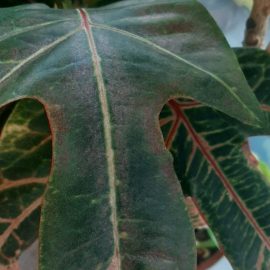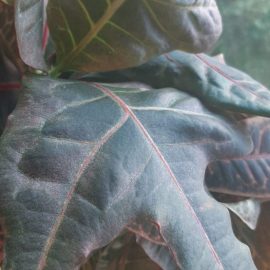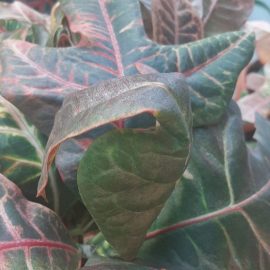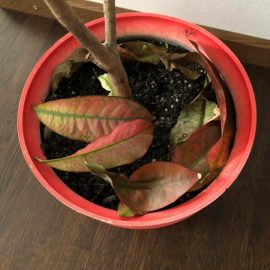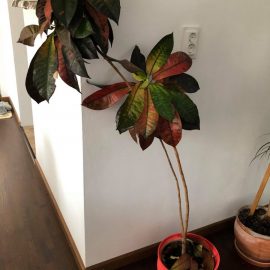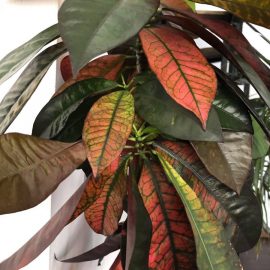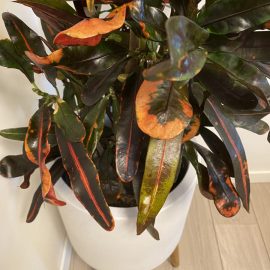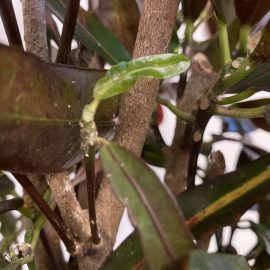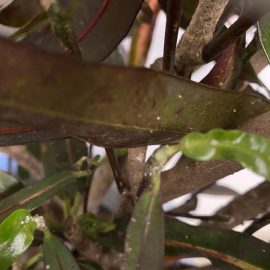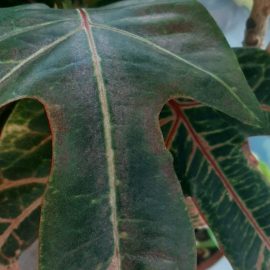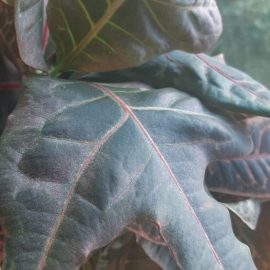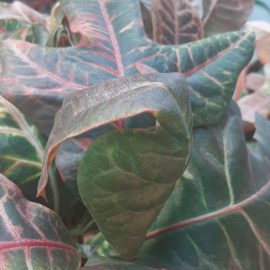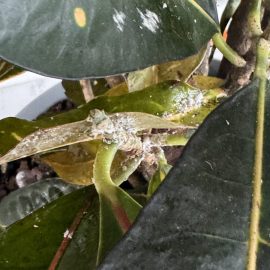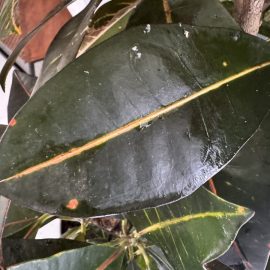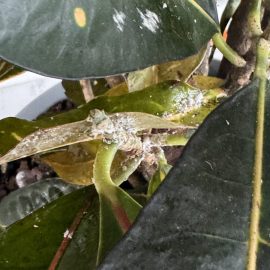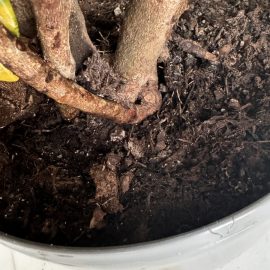Codiaeum, plant care and growing guide
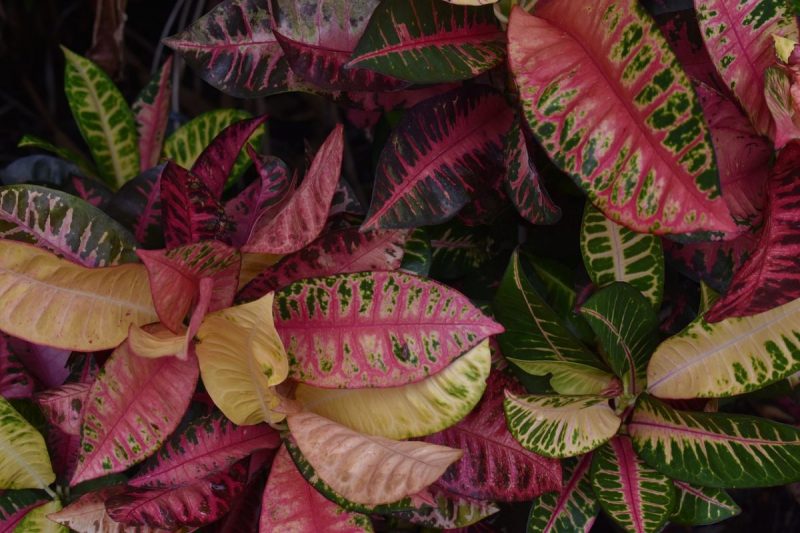
Codiaeum or Garden croton is a tropical shrub, cultivated as an indoor plant for its beautifully colored foliage in combinations of purple, red, orange, pink, light green, and yellow. The plants have thick stems, with linear, lanceolate, or lobed leaves, arranged alternately, with yellow, red, or orange designs. The leaves change color depending on the age of the plant, the young ones developing green leaves that over time turn first yellow and then red.
Species and varieties
Codiaeum variegatum ‘angustifolium’ has leaves with wavy edges, which are long and linear, green, with small spots in shades of yellow.
Codiaeum variegatum ‘spirale’ has twisted leaves in shades of green, purple, and red.
Codiaeum variegatum ‘Petra’ has elliptical leaves, with yellow ribs, while the rest of the foliar limb is green or red.
Garden croton is a decorative plant thanks to its leaves, with continuous vegetation and slow growth, very pretentious to environmental factors.



Temperature. For adequate growth, warm spaces are recommended, with temperatures that can vary between 18 and 25° C and with high atmospheric humidity. In summer it can be placed outdoors, in a place away from direct sunlight. Varieties with narrower leaves and larger green and red areas on their leaves are less prone to sunburn.
Substrate. Garden croton prefers a fertile, permeable substrate with a slightly acidic pH, which favors the leaves’ pigmentation. To improve drainage, it is recommended to mix the substrate with compost and sand.
Recommended products
-
You can find products on a different store
Change Store -
You can find products on a different store
Change Store -
You can find products on a different store
Change Store -
You can find products on a different store
Change Store -
You can find products on a different store
Change Store -
You can find products on a different store
Change Store -
You can find products on a different store
Change Store -
You can find products on a different store
Change Store -
You can find products on a different store
Change Store -
You can find products on a different store
Change Store -
You can find products on a different store
Change Store -
You can find products on a different store
Change Store -
You can find products on a different store
Change Store -
You can find products on a different store
Change Store -
You can find products on a different store
Change Store -
You can find products on a different store
Change Store -
You can find products on a different store
Change Store -
You can find products on a different store
Change Store -
You can find products on a different store
Change Store -
You can find products on a different store
Change Store -
You can find products on a different store
Change Store -
You can find products on a different store
Change Store -
You can find products on a different store
Change Store -
You can find products on a different store
Change Store
Watering. It should be regularly done throughout the warm season, with water at room temperature, since cold water can cause leaf fall. During winter, given that light intensity is lower, smaller amounts of water should be administered and the substrate should be allowed to dry on the surface, between watering the plant again.
Fertilization. It should be done regularly, twice a month during the summer, with mineral or organic fertilizers. In winter the fertilization should be stopped. You should resume it in spring when the plant shows signs of new growth.
Recommended products
-
You can find products on a different store
Change Store -
You can find products on a different store
Change Store -
You can find products on a different store
Change Store -
You can find products on a different store
Change Store -
You can find products on a different store
Change Store -
You can find products on a different store
Change Store -
You can find products on a different store
Change Store -
You can find products on a different store
Change Store -
You can find products on a different store
Change Store -
You can find products on a different store
Change Store -
You can find products on a different store
Change Store -
You can find products on a different store
Change Store -
You can find products on a different store
Change Store -
You can find products on a different store
Change Store -
You can find products on a different store
Change Store -
You can find products on a different store
Change Store -
You can find products on a different store
Change Store -
You can find products on a different store
Change Store -
You can find products on a different store
Change Store -
You can find products on a different store
Change Store -
You can find products on a different store
Change Store -
You can find products on a different store
Change Store -
You can find products on a different store
Change Store -
You can find products on a different store
Change Store
Repotting. It is recommended to be done in spring, once every 2-3 years, when the pot becomes too small for the roots. It is recommended that the transplanting be done in a pot with a diameter that is 2-7 cm larger than the previous one, depending on the size of the plant.
Propagation. It should be done through cuttings from the top of the plant, which have 4-5 leaves, and are 6-7 cm long, in late winter or autumn, in August-September, when the plants contain less latex. The cuttings should be put in warm water (27° C), for 10-15 minutes, to coagulate the latex. They are recommended to be planted in 6-7 cm pots, in a mixture of peat and perlite, at temperatures of 22-25° C and high atmospheric humidity (90%). Rooting lasts 3-4 weeks. Another very efficient method of propagation is air layering, which can be done in March, on the branches of large plants. The stems subjected to this procedure must have 6-7 leaves above the layering area.
Recommended products
-
You can find products on a different store
Change Store -
You can find products on a different store
Change Store -
You can find products on a different store
Change Store -
You can find products on a different store
Change Store -
You can find products on a different store
Change Store -
You can find products on a different store
Change Store -
You can find products on a different store
Change Store -
You can find products on a different store
Change Store -
You can find products on a different store
Change Store -
You can find products on a different store
Change Store -
You can find products on a different store
Change Store -
You can find products on a different store
Change Store -
You can find products on a different store
Change Store -
You can find products on a different store
Change Store -
You can find products on a different store
Change Store -
You can find products on a different store
Change Store -
You can find products on a different store
Change Store -
You can find products on a different store
Change Store -
You can find products on a different store
Change Store -
You can find products on a different store
Change Store -
You can find products on a different store
Change Store -
You can find products on a different store
Change Store -
You can find products on a different store
Change Store -
You can find products on a different store
Change Store
The most common pests that attack the plant are mites, thrips, and mealybugs.
In addition:
- it is recommended that during the winter the plants benefit from a dormancy period, by decreasing the temperature slightly, and reducing the amount of water administered, given the fact that the light intensity is lower compared to summer.
- drafts, excessive water and the sudden variations of temperature determine the withering and the fall of the leaves.
- during the summer it is recommended to spray the leaves with water, several times a day.
- insufficient light causes the leaves to lose their color and, especially, their shine.
- a sudden change in location or temperature is not recommended as it may cause the leaves to fall.
- Codiaeum is sensitive to dust and, therefore, it is recommended to wipe it regularly with a damp sponge on both sides.














































































































































































































































































































































































































































